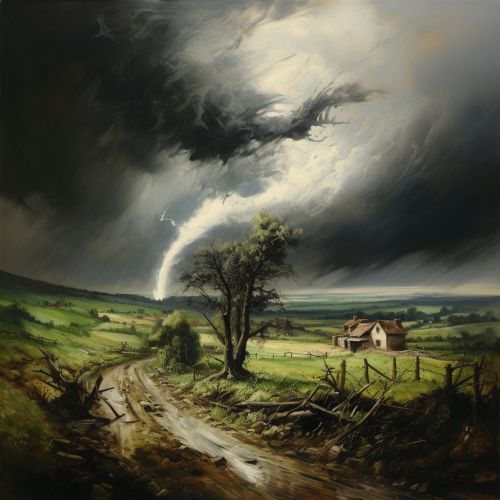Tornado intensity and damage
Introduction
Tornado intensity and damage are closely interrelated topics in the field of meteorology. A tornado is a rapidly rotating column of air that is in contact with both the surface of the Earth and a cumulonimbus cloud or, in rare cases, the base of a cumulus cloud. The strongest tornadoes can produce intense damage, uprooting trees and structures and hurling objects through the air like deadly missiles. Although violent tornadoes comprise only two percent of all tornadoes, they are responsible for 70 percent of tornado-related fatalities.


Tornado Intensity
Tornado intensity is primarily measured by the EF scale, which replaced the older Fujita scale in 2007 in the United States and in 2013 in Canada. The EF scale rates tornadoes from EF0, being the weakest, to EF5, being the strongest. The scale is based on the damage caused by a tornado to human-built structures and vegetation. The wind speeds associated with the damage are estimates derived from a set of wind speed ranges. The EF scale is a set of 28 damage indicators (DI), each with a varying number of degrees of damage (DOD). Each DOD is associated with a range of wind speeds.
Damage Indicators and Degrees of Damage
The EF scale currently lists 28 damage indicators (DI), which are types of structures or vegetation, each with a varying number of degrees of damage (DOD). These DIs range from small barns to large shopping malls, from hardwood trees to palm trees. Each DOD is associated with a range of wind speeds. The DODs are used to analyze the damage caused by a tornado, and from that, an EF rating is assigned. The EF scale was designed so that a tornado rated on the EF scale would receive a similar rating to a tornado rated on the original Fujita scale.
Tornado Damage
Tornado damage can be catastrophic and varies greatly in intensity, from damaging roofs or uprooting trees (EF0) to leveling houses and hurling cars as if they were toys (EF5). The damage path of a tornado can be in excess of one mile wide and 50 miles long. Tornadoes can also cause damage by creating debris. Debris causes damage by hitting other objects, and can also cause injury or death to people and animals. In addition, tornadoes can cause damage when the wind gets inside a structure and blows it apart from the inside.


Factors Influencing Tornado Intensity and Damage
The intensity and damage caused by a tornado are influenced by several factors. These include the size and structure of the tornado, the speed and direction of the tornado's movement, the angle at which the tornado strikes a structure, and the characteristics of the local environment, including the nature of the ground surface and the type and quality of human structures.
Mitigation of Tornado Damage
Mitigation of tornado damage involves measures taken to minimize the impact of tornadoes. This can involve building design and construction practices, early warning systems, and community preparedness programs. For example, in tornado-prone areas, homes and other buildings can be constructed to resist the forces generated by a tornado. This can include reinforced concrete construction, the use of hurricane straps to secure the roof to the walls, and the use of storm cellars or safe rooms.
